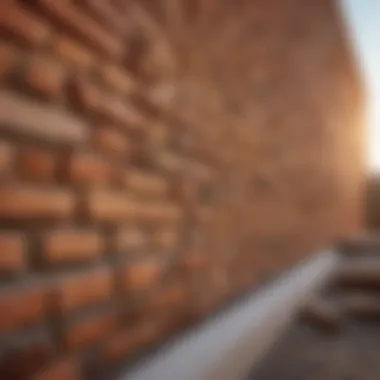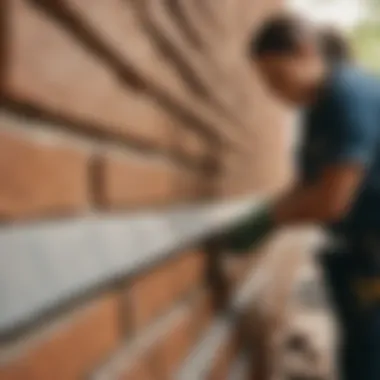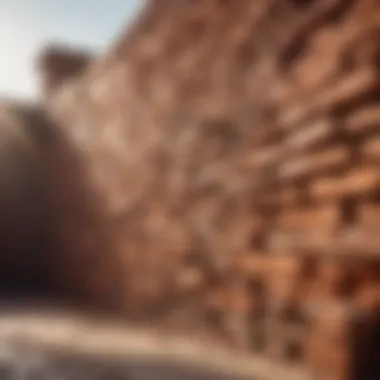Materials:
To begin the construction of a brick retaining wall, it is essential to gather the necessary materials for a successful project. The list below outlines each item required with precise measurements to ensure accuracy and efficiency:
-
Bricks: Purchase high-quality bricks, ensuring there are enough to cover the desired length and height of the wall. Measure the dimensions of the area to calculate the quantity needed accurately.
-
Gravel: Acquire gravel to create a solid foundation for the wall. The amount needed depends on the size of the wall and the depth required for stability.
-
Sand: Procure sand for laying a sturdy base and for filling gaps between the bricks. The right type of sand is crucial for proper cohesion.
-
Cement: Invest in good quality cement to bind the bricks together securely. The quantity required varies based on the size of the wall.
-
Landscape Fabric: Obtain landscape fabric to prevent weeds from growing through the wall over time. Measure the area to cut the fabric to the appropriate size.
-
Drainage Pipe: Secure a drainage pipe to ensure proper water runoff behind the wall, preventing water damage and erosion. Cut the pipe to fit the length of the wall.
-
Reinforcing Bar: Purchase reinforcing bar to add structural strength to the wall, especially for taller or heavier walls. Cut the bars as needed to reinforce key sections.
-
Backfill Material: Get backfill material to fill behind the wall for additional support. The amount required depends on the height and length of the wall.
DIY Steps:
Once all the materials are gathered, it is time to embark on the step-by-step process of constructing a brick retaining wall. Follow the detailed instructions below to ensure a successful and durable outcome:
-
Excavation: Begin by excavating the area where the wall will be built, ensuring it is level and has the necessary depth for a stable foundation.
-
Base Preparation: Lay a base of gravel and sand to establish a solid foundation for the wall, ensuring proper drainage and stability.
-
Brick Placement: Start placing bricks according to the desired pattern, using cement to secure them in place. Pay attention to alignment and levelness for a professional finish.
-
Backfilling: Fill behind the wall with backfill material, compacting it as you go to provide additional support and improve stability.
-
Reinforcement: Insert reinforcing bars at key intervals within the wall to enhance its structural integrity, especially for taller walls.
-
Drainage Installation: Place the drainage pipe behind the wall to direct water away from the structure, preventing damage and erosion.
-
Finishing Touches: Once the wall is completed, ensure all gaps are filled with sand and perform any necessary adjustments to achieve a polished look.
Technical Aspects:
In addition to the materials and DIY steps, there are several technical aspects to consider for a successful brick retaining wall construction project. Pay attention to the following details to elevate the quality and durability of your DIY endeavor:
-
Tools: Prepare essential tools such as a shovel, level, trowel, rubber mallet, and a saw for cutting bricks or reinforcing bars to size.
-
Timing: Plan the construction process carefully, considering weather conditions and allowing sufficient time for each step to ensure proper curing and stability.
-
Critical Techniques: Master techniques such as brick laying, backfill compaction, and drainage installation to ensure a structurally sound and aesthetically pleasing outcome.
DIY Project Process:


Following the sequential steps outlined above is crucial for a successful brick retaining wall construction project. By meticulously following each instruction, you can create a durable and visually appealing structure. In case of any common mistakes or challenges during the process, refer to the troubleshooting tips provided to make necessary adjustments and ensure the integrity of the wall.
Introduction


The task of constructing a brick retaining wall is a significant undertaking that requires careful planning, precise execution, and a thorough understanding of the associated costs. In this comprehensive guide focused on the cost aspect, we will delve deep into the financial intricacies of building a brick retaining wall. While the aesthetic appeal and structural benefits of such a wall are apparent, it is crucial to grasp the financial implications that come with this construction project.
To embark on this journey, one must consider various elements that contribute to the overall expenses involved. From material costs to labor charges, each aspect plays a crucial role in determining the total investment required to build a brick retaining wall. By unraveling the layers of expenses associated with this endeavor, we aim to provide a detailed roadmap that equips homeowners and DIY enthusiasts with the necessary knowledge to make informed decisions and optimize their budget effectively.
Throughout this guide, we will analyze different factors influencing the cost of building a brick retaining wall, explore methods to reduce construction expenses, and shed light on additional cost considerations that are often overlooked. By the end of this article, readers will have a comprehensive understanding of the financial commitments associated with such a project, empowering them to proceed with clarity and confidence in their construction endeavors.
Factors Influencing Brick Retaining Wall Cost


In this in-depth article focusing on the cost of building a brick retaining wall, understanding the factors influencing the overall expense is paramount. Material costs, labor expenses, and equipment and tool costs play significant roles in determining the final budget of such a construction project. By delving into each of these elements, readers can gain a comprehensive insight into the financial considerations involved in building a brick retaining wall.
Material Costs
Brick Cost per Square Foot
The cost of bricks per square foot is a crucial component of the overall expenses when constructing a brick retaining wall. The pricing of bricks can vary based on factors such as material quality, design, and brand. Typically, brick cost per square foot ranges from X to Y dollars, making it a cost-effective choice for durable and aesthetically pleasing retaining walls. The advantage of using bricks lies in their longevity and minimal maintenance requirements, making them a popular option for homeowners looking for longevity and aesthetic appeal in their landscapes.
Additional Materials Cost
Apart from bricks, additional materials such as mortar, gravel, and drainage components also contribute to the overall material expenses of building a brick retaining wall. These additional materials ensure structural integrity, proper drainage, and enhance the overall functionality of the wall. While adding to the total cost, they are essential for ensuring the longevity and stability of the retaining wall. Understanding the specific requirements and costs of these additional materials is crucial for accurate budgeting and successful project completion.
Labor Expenses
Labor expenses represent a significant portion of the total cost of constructing a brick retaining wall. Hiring skilled masons or contractors to build the wall ensures quality craftsmanship and adherence to construction standards. Labor costs can vary based on factors such as the complexity of the design, the site's accessibility, and the laborers' experience. Properly budgeting for labor expenses is essential to achieving a well-built and structurally sound brick retaining wall.
Equipment and Tool Costs
In addition to material and labor costs, equipment and tool expenses must also be considered when planning for a brick retaining wall project. Renting or purchasing tools such as saws, levels, and trowels is necessary for proper installation and site preparation. These costs add to the overall budget but are essential for ensuring precision and efficiency during the construction process. Understanding the equipment and tool requirements and associated costs is vital for a successful and cost-effective brick retaining wall project.
Average Cost of Building a Brick Retaining Wall
In the realm of constructing a brick retaining wall, understanding the average cost is vital as it forms the backbone of financial planning for such a project. The Average Cost of Building a Brick Retaining Wall encapsulates various crucial aspects that ultimately determine the total expenditure involved. From material costs to labor expenses, every element contributes to the overall average cost, making it a pivotal focal point in this article. By delving into the intricacies of the average cost, individuals can gain a comprehensive outlook on the financial commitments necessary for executing a brick retaining wall construction efficiently.
Cost Breakdown
Per Square Foot Cost
The Per Square Foot Cost plays a pivotal role in shaping the overall financial landscape of building a brick retaining wall. This specific aspect offers a detailed insight into the material expenses required per square foot of the construction. Understanding the Per Square Foot Cost is essential as it allows individuals to estimate the total material budget accurately. The key characteristic of Per Square Foot Cost lies in its ability to provide a transparent view of how much material is needed for every square foot of the wall, facilitating precise budgeting. One of the notable advantages of this cost breakdown is its precision in gauging the material requirements, ensuring a streamlined procurement process for materials. However, one disadvantage could be the variability in material prices, which might lead to fluctuations in the overall cost.
Total Installation Cost
When embarking on the journey of constructing a brick retaining wall, the Total Installation Cost becomes a fundamental element in the financial planning process. This aspect encompasses not only material expenses but also labor costs, equipment charges, and any additional fees related to the installation process. Highlighting the comprehensive nature of Total Installation Cost is crucial as it presents a holistic view of the overall expenditure required for completing the construction project successfully. The key characteristic of Total Installation Cost lies in its ability to consolidate all financial elements into a single figure, simplifying the budgeting process for individuals. One of the advantageous features of this cost breakdown is its inclusivity, ensuring that all relevant expenses are accounted for in the budget. However, a potential disadvantage could be the complexity of evaluating multiple cost components, which might require keen attention to detail to avoid oversights.
Methods to Reduce Brick Retaining Wall Construction Expenses
In the quest to minimize the financial burdens associated with building a brick retaining wall, exploring various methods to reduce construction expenses becomes pivotal. One of the primary considerations in this realm is the choice between DIY installation and hiring professionals. When contemplating this decision, homeowners must weigh the benefits and drawbacks carefully.
DIY vs. Professional Installation
Opting for a DIY approach to constructing a brick retaining wall can significantly slash costs, as labor expenses are notably reduced. However, it's essential to acknowledge the expertise and time commitment required for this undertaking. DIY enthusiasts must possess adequate skills in bricklaying and wall construction to ensure a sturdy and durable end result. On the contrary, professional installation guarantees high-quality workmanship but comes at a higher initial price tag. Homeowners willing to invest more upfront can benefit from the expertise of seasoned masons and the assurance of a professionally executed project.
Alternative Material Options
Another avenue to curbing expenses lies in exploring alternative material options for building a retaining wall. While bricks are traditional and aesthetically pleasing, other materials such as concrete blocks or treated wood may offer cost-effective alternatives. By assessing the cost comparison between various materials and considering factors like durability, maintenance, and visual appeal, homeowners can make an informed decision that aligns with their budget constraints.
Comparative Cost Analysis
Conducting a comprehensive cost analysis comparing different approaches to brick retaining wall construction is indispensable. This entails weighing the total expenses associated with DIY installation versus hiring professionals, as well as evaluating the pros and cons of using alternative materials. By delving into the nitty-gritty of cost breakdowns, labor fees, material prices, and long-term maintenance considerations, individuals can make a well-informed choice that optimizes both budget efficiency and outcome quality.
Additional Cost Considerations
In the realm of constructing a brick retaining wall, Additional Cost Considerations emerge as a crucial aspect that necessitates meticulous consideration. These additional costs go beyond the basic material and labor expenditures, encompassing various elements that can significantly impact the overall financial outlay of the project. Understanding and incorporating these supplementary expenses into the budgeting process is imperative for ensuring a smooth and successful construction endeavor.
One primary element within Additional Cost Considerations is Permit Costs. Obtaining the necessary permits for building a brick retaining wall is a fundamental requirement, varying in cost depending on the location and scope of the project. Permit Costs encompass fees charged by local authorities to authorize the construction, ensuring compliance with building regulations and standards.
Moreover, another crucial aspect falling under Additional Cost Considerations is Maintenance and Repair Fees. While initial construction costs are significant, it's essential to factor in the long-term upkeep expenses associated with maintaining the structural integrity of the brick retaining wall. Maintenance costs can include regular inspections, repairs, cleaning, and potential reinforcements to address wear and tear, weathering, or structural issues over time. Accounting for these ongoing maintenance and repair fees in the overall budgeting process is essential for preserving the durability and functionality of the brick retaining wall in the years to come. Thus, by delving deep into the realm of Additional Cost Considerations, individuals embarking on a brick retaining wall construction project can proactively plan and prepare for the financial commitments beyond the initial build, ensuring a sturdy and enduring structure for the future enjoyment and benefit of their properties.
Conclusion
The conclusion of this comprehensive guide on the cost of building a brick retaining wall is essential for not only summarizing the key points discussed but also for highlighting the crucial aspects that housewives and homeowners need to take into consideration before embarking on such a project. By understanding the intricacies of the financial commitments involved in constructing a brick retaining wall, individuals can make well-informed decisions that align with their budget and expectations.
One of the main benefits of this conclusion is its ability to emphasize the significance of proper planning and budgeting when undertaking a construction project of this nature. It underscores the need to factor in material costs, labor expenses, equipment and tool costs, permit fees, maintenance, and repair costs, among others, to ensure a smooth and successful building process. By shedding light on these elements, the conclusion serves as a guidepost for readers, empowering them to approach the project with clarity and foresight.
Moreover, the conclusion acts as a compass that directs readers from the initial stages of planning to the eventual satisfaction of enjoying the completed brick retaining wall. It encapsulates the journey from envisioning the project, navigating through the cost considerations, and executing the construction to finally basking in the beauty and functionality of the structure. This holistic approach not only educates but also motivates readers to engage in the process with confidence and understanding.
In essence, this conclusion acts as a strategic tool that equips housewives and homeowners with the knowledge and foresight necessary to tackle the financial aspects of building a brick retaining wall. By distilling complex financial information into actionable insights and considerations, it enables readers to make informed decisions and embark on their construction project with clarity and preparedness.





